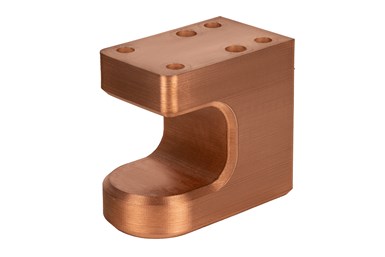DesktopMetal Introduces Pure Copper for its Studio System
Unlike laser-based processes (which often print chromium zirconium copper), the Studio System’s Bound Metal Deposition process is able to print pure copper, unlocking the full benefits of the material.

Electrode holder printed in copper part features internal conformal cooling channels to improve temperature regulation.
Desktop Metal expands its metal 3D printing materials library with launch of Pure Copper for the Studio System, an office-friendly metal 3D printing system for low volume production.
With its excellent thermal and electrical conductivity, copper is well suited for transferring heat or electricity and enables high-performance, highly optimized parts. Copper is used in virtually every electronic device, as well as in many of the heat exchangers used across a variety of industries, including oil and gas, automotive, and consumer products.
A key benefit for Desktop Metal customers is that the copper material used with the Studio System is pure copper. Unlike laser-based processes (which often print chromium zirconium copper), the Studio System’s Bound Metal Deposition process is able to print pure copper, thus unlocking the full benefits of the material.
According to the company, copper is a highly desired material for a variety of applications, such as heat exchangers and electrical components. Whether for heat sinks, electrical motor and power grid components, or resistance welding electrodes, 3D printed copper on the Studio System is well suited for manufacturing parts featuring complex geometries.
When combined with Desktop Metal’s in-house expertise in material processing, binder compounds and metal 3D printing, the results are high-quality metal parts with affordable material costs. Users can easily 3D print difficult-to-machine parts with up to 98% density and featuring complex geometry-like undercuts and internal channels. Fabricate software automates complicated metallurgical processes to produce high-quality parts with densities and feature accuracy similar to casting.
The Studio System is built to make 3D printing metal parts as easy as uploading a design to Fabricate software and pressing print with no guesswork or manual calculations required. Material changeovers are quick and easy, enabled by a unique, hot-swappable material cartridge design.
Related Content
-
Sintavia Receives Strategic Investment from Lockheed Martin
The equity investment will support continued development of Sintavia’s proprietary thermodynamic designs and components.
-
3D Printed Heat Exchanger Illustrates Siemens' CATCH and Release Approach
Solutions for energy efficiency, sustainability, part repair and more are developing at Siemens’ Charlotte Advanced Technology Collaboration Hub (CATCH) in North Carolina.
-
8 Cool Parts From Formnext 2023: The Cool Parts Show #65
New additive manufacturing technologies on display at Formnext were in many cases producing notable end-use components. Here are some of the coolest parts we found at this year’s show.














